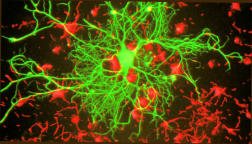
Alzheimer's Type II Astrocytes
The Wonderful world of the Astrocytes
While Alzheimer's Type ii Astrocytes shouldn’t be confused with Alzheimer's Dementia pere sa, there may well be similarities. Elevated levels of ammonia can lead to astrocyte swelling and may contribute to brain oedema. If there is too much ammonia in the brain, the astrocytes can start to become damaged and begin to swell. They start to become less effective and so can’t clear away debris from the neurons and synapses . While research is still very much ongoing, it should be noted that at the moment it isn’t exactly clear what effect of someone with Liver Cirrhosis has on the astrocytes, Much research is going on all over the world, and it’s only a question of time before we have a greater understanding of what is exactly going on. In this next video, it can be seen just how important the role of the astrocytes really is. Here Assoc Prof Nicola Allen, (lovely name) explains how the astrocytes help the neurons to communicate with each other. It’s now easy to see how everything can become messed up when the astrocytes become damaged by too much ammonia. They can no longer clear away debris, which in turn prevents the neurons from passing signals to each other.
As can be seen in these videos, the synapses are kept clear by the astrocytes so that communication between neurons can take place. In this next video Prof Elly Hol, from the
Netherlands, explains that in the case of Alzheimer's, the astrocytes can take on a more immune response role, but in doing so leaves the
neurons and
synapses unprotected,
this can then inhibit the neurons from communicating with each other. This communication breakdown can bring about forgetfulness and memory loss in patients. This
sequentially can bring about a feeling of frustration and personality changes as seen in cases of hepatic encephalopathy.
In this next video, Nicola explains how Astrorocytes appear to play a much more important role than just housekeeping the neurons and making sure they behaved correctly.
However, it now appears that the Astrorocytes are actually instructing the neurons on how to make these connections. Once again, it’s easy to understand how messed up a brain
can become when the Astrorocytes become damaged by the overabundance of ammonia in the brain.
Astrocytes are just one type of Glial Cell. So, what are Glial Cells and what do they do?
Glial cells are a type of cell that provides physical and chemical support to neurons and maintain their environment. Located in the central nervous system and peripheral nervous
system, glial cells are sometimes called the "glue" of the nervous system, as well as neuroglia or just glia.
What about another type of Glial Cell called “Microglia”
The liver can lose its ability to function during acute liver failure or chronic liver disease. When this occurs, toxins, such as ammonia, enter the circulation and can enter the brain.
After accumulating in neural tissue, they cause a disruption of astrocyte and microglia cellular function. Astrocytes metabolize ammonia, leading to an increase of glutamine, cell
swelling, cerebral edema, oxidative stress and hyperlactatemia. Microglia become activated leading to increased neuroinflammation due to pro-inflammatory cytokine release
and oxidative stress. Together, these changes in neural cellular function lead to increased HE pathology, resulting in increased morbidity and mortality.
Hopefully the video below may explain things a little better.




























